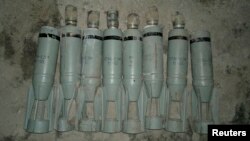GENEVA —
Activists campaigning against cluster munitions are condemning Syria’s alleged use of this banned weapon. At the same time, the newly released Cluster Munition Monitor 2013 report finds that, in general, great progress is being made in the implementation of the 2008 Convention, which calls for the ban and elimination of these weapons.
The report says governments are making progress to eliminate cluster bombs. The authors say the rate at which states are destroying millions of stockpiled cluster munitions is making a real difference in saving lives.
According to Mary Wareham, editor of the Cluster Munition Monitor, cluster munitions have been used by at least 20 governments in at least 36 countries since the end of World War II.
But since the Convention banning cluster munitions came into force in 2010, Wareham said there are no reports of these weapons being used by participants in the convention agreement.
“We have, however, documented extensive use in Syria by the Syrian government pretty much starting mid-2012, increasing as the air campaign intensified in October 2012, continuing into 2013. And we believe cluster munitions are still being used ... Human Rights Watch has documented a lot of that use ... We have identified 152 locations across Syria where at least 204 separate cluster munitions have been used,” said Wareham.
The Syrian government said it does not use cluster bombs against rebels or civilians. But human rights groups said they have accumulated an array of evidence proving otherwise.
Case in point
Screen capture from video shot by VOA earlier this year showed remains of bombs with Russian markings that appear to bolster the activists' claims the Syrian government used cluster bombs in northern Syria.
Residents of Azaz told VOA that Syrian government forces dropped nine large cluster bombs, what arms experts said is a particularly deadly weapon, on a neighborhood near the outskirts of town.
Most of the use has been in the north of the country, Wareham said, but almost every region has been affected by cluster bombs. She said the Syrian government denies using cluster weapons or even of possessing them.
Besides Syria, the report said a few other countries that are not party to the treaty reportedly have used cluster munitions.
It said Burmese government forces may have used a weapon prohibited by the Convention in Kachin State in late 2012 and early 2013, adding that there are unconfirmed reports of cluster munition use by Sudan in 2012 and 2013. It said Libya and Thailand used the weapons in 2011.
Wareham said most nations that are part of the treaty are destroying their stockpiles.
“To date, we have recorded over one million cluster munitions and 122 million sub-munitions destroyed by 22 states parties. That is in total to date. It represents more than half of the cluster munitions that States parties have declared,” she said.
According to the report, more than 59,000 unexploded submunitions were destroyed during clearance projects across 11 nations in 2012. These include heavily contaminated states such as Afghanistan, the Democratic Republic of Congo and Lebanon.
Last year, 190 cluster munition casualties were reported with at least 165 of them in Syria.
The report says governments are making progress to eliminate cluster bombs. The authors say the rate at which states are destroying millions of stockpiled cluster munitions is making a real difference in saving lives.
According to Mary Wareham, editor of the Cluster Munition Monitor, cluster munitions have been used by at least 20 governments in at least 36 countries since the end of World War II.
But since the Convention banning cluster munitions came into force in 2010, Wareham said there are no reports of these weapons being used by participants in the convention agreement.
“We have, however, documented extensive use in Syria by the Syrian government pretty much starting mid-2012, increasing as the air campaign intensified in October 2012, continuing into 2013. And we believe cluster munitions are still being used ... Human Rights Watch has documented a lot of that use ... We have identified 152 locations across Syria where at least 204 separate cluster munitions have been used,” said Wareham.
The Syrian government said it does not use cluster bombs against rebels or civilians. But human rights groups said they have accumulated an array of evidence proving otherwise.
Case in point
Screen capture from video shot by VOA earlier this year showed remains of bombs with Russian markings that appear to bolster the activists' claims the Syrian government used cluster bombs in northern Syria.
Residents of Azaz told VOA that Syrian government forces dropped nine large cluster bombs, what arms experts said is a particularly deadly weapon, on a neighborhood near the outskirts of town.
Most of the use has been in the north of the country, Wareham said, but almost every region has been affected by cluster bombs. She said the Syrian government denies using cluster weapons or even of possessing them.
Besides Syria, the report said a few other countries that are not party to the treaty reportedly have used cluster munitions.
It said Burmese government forces may have used a weapon prohibited by the Convention in Kachin State in late 2012 and early 2013, adding that there are unconfirmed reports of cluster munition use by Sudan in 2012 and 2013. It said Libya and Thailand used the weapons in 2011.
Wareham said most nations that are part of the treaty are destroying their stockpiles.
“To date, we have recorded over one million cluster munitions and 122 million sub-munitions destroyed by 22 states parties. That is in total to date. It represents more than half of the cluster munitions that States parties have declared,” she said.
According to the report, more than 59,000 unexploded submunitions were destroyed during clearance projects across 11 nations in 2012. These include heavily contaminated states such as Afghanistan, the Democratic Republic of Congo and Lebanon.
Last year, 190 cluster munition casualties were reported with at least 165 of them in Syria.
Loading...








